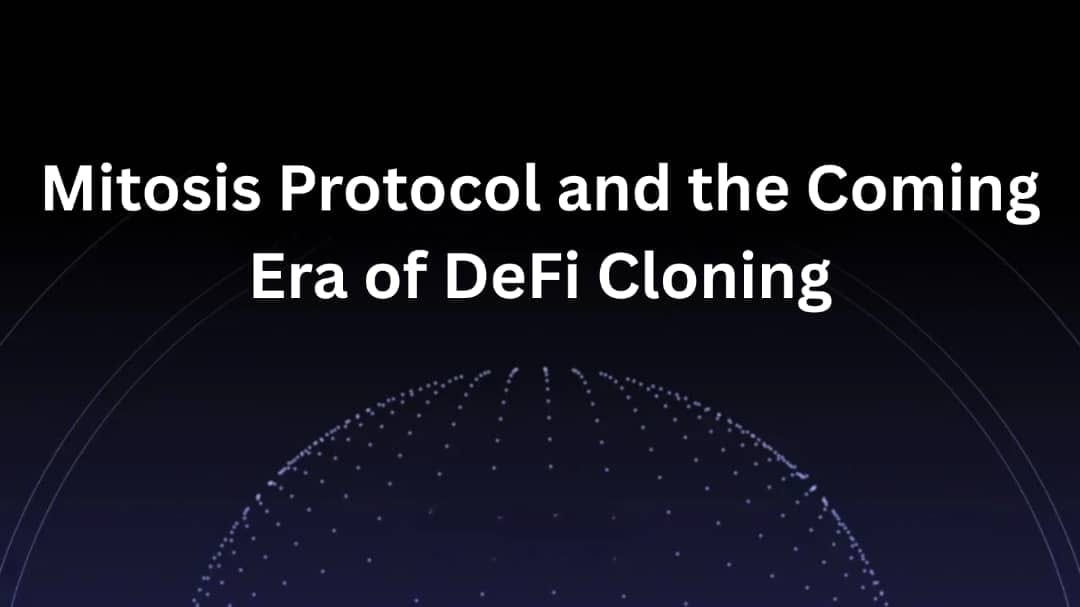Mitosis Protocol and the Coming Era of DeFi Cloning

Introduction
The decentralized finance (DeFi) landscape has witnessed rapid evolution over the past few years, with innovative protocols emerging to address various financial needs. One of the most intriguing concepts to arise in this space is the Mitosis Protocol, which introduces the idea of protocol replication and governance splits. This article delves into the intricacies of the Mitosis Protocol, exploring the implications of modular DeFi cloning, governance structures, and the potential for a new era in decentralized finance.
1. Understanding Mitosis in Biological Terms
Before diving into the Mitosis Protocol, it is essential to understand the biological concept of mitosis. Mitosis is the process by which a single cell divides into two identical daughter cells, each containing the same genetic material. This process is crucial for growth, development, and repair in living organisms. In the context of DeFi, the Mitosis Protocol draws an analogy to this biological process, suggesting that financial protocols can replicate and evolve to meet the changing needs of users.
2. The Need for Protocol Replication in DeFi
1. Rapid Innovation
The DeFi space is characterized by rapid innovation, with new protocols and platforms emerging almost daily. This fast-paced environment necessitates a mechanism for protocols to adapt and evolve quickly. Protocol replication allows developers to build upon existing frameworks, leveraging successful features while introducing new functionalities.
2. Customization and Specialization
Different DeFi applications serve various purposes, from lending and borrowing to decentralized exchanges and yield farming. Protocol replication enables developers to create specialized versions of existing protocols tailored to specific use cases or target audiences. This customization fosters a diverse ecosystem that can cater to a wide range of financial needs.
3. Risk Mitigation
In the DeFi space, risks such as smart contract vulnerabilities and market volatility are prevalent. By replicating successful protocols, developers can create safer alternatives that incorporate lessons learned from previous failures. This iterative approach to development can help mitigate risks and enhance the overall security of the DeFi ecosystem.
3. The Mitosis Protocol: An Overview
The Mitosis Protocol is a framework designed to facilitate the replication of DeFi protocols while maintaining a focus on governance and community involvement. It introduces several key concepts that are essential for understanding its functionality:
1. Modular Architecture
The Mitosis Protocol employs a modular architecture, allowing developers to create and deploy new protocols by combining existing components. This modularity enables greater flexibility and adaptability, as developers can easily swap out or upgrade individual modules without overhauling the entire system.
2. Governance Splits
One of the most significant innovations of the Mitosis Protocol is the concept of governance splits. In traditional DeFi protocols, governance is often centralized, with a small group of stakeholders making decisions on behalf of the entire community. The Mitosis Protocol introduces a decentralized governance model that allows for multiple governance structures to coexist within a single ecosystem.
a. Layered Governance
The Mitosis Protocol supports layered governance, where different layers of governance can be established for various aspects of a protocol. For example, a lending protocol may have one governance layer focused on interest rates and another dedicated to risk management. This separation of concerns allows for more specialized decision-making and enhances the overall efficiency of governance processes.
b. Community Involvement
The Mitosis Protocol emphasizes community involvement in governance decisions. By allowing users to participate in the governance process, the protocol fosters a sense of ownership and accountability among stakeholders. This participatory approach can lead to more informed decision-making and a stronger alignment between the protocol's goals and the needs of its users.
3. Incentive Structures
Incentives play a crucial role in the success of any DeFi protocol. The Mitosis Protocol incorporates innovative incentive structures to encourage participation and engagement within the ecosystem. These incentives can take various forms, including token rewards, governance rights, and access to exclusive features.
4. The Process of DeFi Cloning
1. Identifying Successful Protocols
The first step in the DeFi cloning process is identifying successful protocols that have demonstrated strong performance and user adoption. Developers can analyze various metrics, such as total value locked (TVL), user engagement, and community feedback, to determine which protocols are worth replicating.
2. Analyzing Features and Functionality
Once a successful protocol has been identified, developers must analyze its features and functionality. This analysis involves understanding the underlying smart contracts, governance mechanisms, and incentive structures that contribute to the protocol's success. By dissecting these elements, developers can identify which aspects to retain and which to modify in their cloned version.
3. Customizing the Cloned Protocol
After analyzing the original protocol, developers can begin customizing their cloned version. This customization may involve altering the user interface, adjusting fee structures, or implementing new governance mechanisms. The goal is to create a unique offering that retains the successful elements of the original protocol while addressing specific user needs or market gaps.
4. Deploying the Cloned Protocol
Once the cloned protocol has been developed and tested, it can be deployed on the blockchain. This deployment process typically involves launching the smart contracts, establishing liquidity pools, and initiating marketing efforts to attract users. Developers must also ensure that the governance mechanisms are in place to facilitate community involvement from the outset.
5. Case Studies of DeFi Cloning
To illustrate the potential of the Mitosis Protocol and DeFi cloning, let's examine a few notable case studies:
1. Uniswap and SushiSwap
Uniswap is one of the most successful decentralized exchanges (DEXs) in the DeFi space, known for its automated market-making (AMM) model. SushiSwap emerged as a clone of Uniswap, offering similar functionality but with additional features and incentives for liquidity providers. By leveraging Uniswap's success, SushiSwap was able to attract a significant user base and establish itself as a prominent player in the DEX market.
2. Yearn.finance and Forks
Yearn finance is a yield aggregator that optimizes yield farming strategies for users. Several forks of Yearn finance have emerged, each offering unique features and strategies. These forks have allowed developers to experiment with different approaches to yield optimization while benefiting from the established reputation and user base of Yearn finance.
3. Aave and its Variants
Aave is a decentralized lending protocol that has gained widespread adoption. Variants of Aave, such as Aavegotchi, have emerged, combining lending with gaming elements. This cloning process has allowed developers to tap into the growing interest in both DeFi and gaming, creating innovative products that appeal to a broader audience.
6. Challenges and Considerations in DeFi Cloning
While DeFi cloning presents numerous opportunities, it also comes with challenges and considerations that developers must address:
1. Intellectual Property and Ethics
The replication of protocols raises questions about intellectual property and ethical considerations. Developers must navigate the fine line between drawing inspiration from successful protocols and infringing on their intellectual property rights. Establishing clear guidelines for ethical cloning practices is essential to foster a healthy and collaborative DeFi ecosystem.
2. Security Risks
Cloning protocols can introduce security risks, especially if developers do not thoroughly audit their smart contracts. Vulnerabilities in cloned protocols can lead to significant financial losses for users. Developers must prioritize security audits and testing to ensure the safety of their cloned protocols.
3. Community Reception
The success of a cloned protocol often hinges on community reception. Users may be hesitant to adopt a new protocol that appears to be a mere copy of an existing one. Developers must differentiate their offerings and communicate the unique value propositions of their cloned protocols to attract users.
7. The Future of DeFi Cloning and the Mitosis Protocol
As the DeFi landscape continues to evolve, the Mitosis Protocol and the concept of protocol replication are likely to play a significant role in shaping the future of decentralized finance. Several trends and developments may emerge in this space:
1. Increased Collaboration
The Mitosis Protocol encourages collaboration among developers, fostering a culture of sharing knowledge and resources. As more developers embrace this collaborative mindset, we may see an increase in joint ventures and partnerships, leading to the creation of innovative hybrid protocols that combine the best features of multiple projects.
2. Enhanced Governance Models
The emphasis on governance splits within the Mitosis Protocol may lead to the development of more sophisticated governance models. As protocols become more complex, the need for effective governance structures will grow. We may see the emergence of new governance frameworks that prioritize decentralization, transparency, and community involvement.
3. Cross-Protocol Interoperability
The modular nature of the Mitosis Protocol may pave the way for greater interoperability between different DeFi protocols. As developers create cloned protocols that can seamlessly interact with one another, users may benefit from enhanced liquidity, improved user experiences, and more efficient financial services.
4. Regulatory Considerations
As DeFi continues to gain traction, regulatory scrutiny is likely to increase. Developers must stay informed about evolving regulations and ensure that their cloned protocols comply with legal requirements. This may lead to the development of protocols that prioritize compliance while maintaining the core principles of decentralization.
Conclusion
The Mitosis Protocol represents a significant advancement in the DeFi space, introducing the concepts of protocol replication, governance splits, and modular cloning. By leveraging the successes of existing protocols, developers can create innovative solutions that cater to diverse user needs while fostering a collaborative and participatory ecosystem. As the DeFi landscape continues to evolve, the principles outlined in the Mitosis Protocol will likely play a crucial role in shaping the future of decentralized finance.



Comments ()